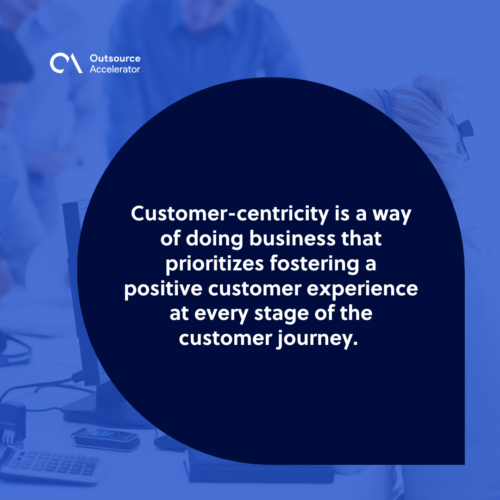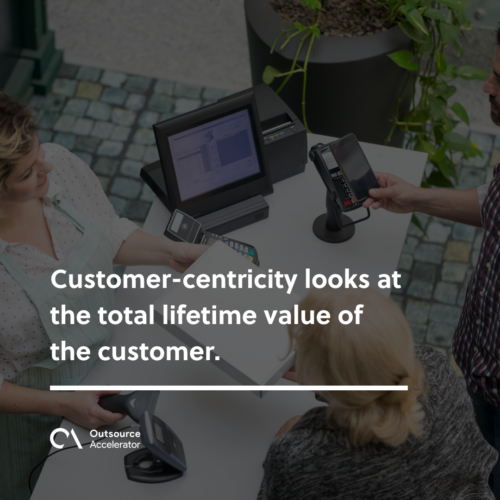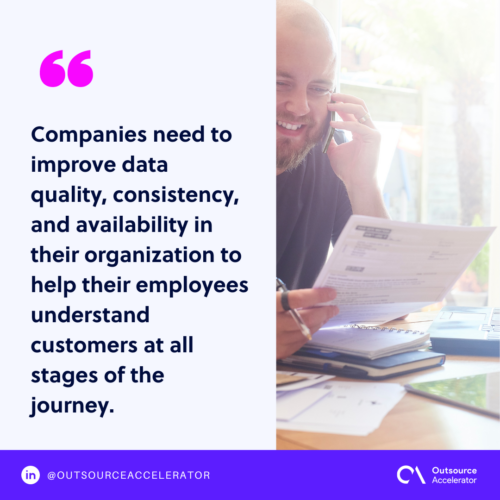Customer-centricity: What it is and how to do it

Many companies claim to be customer-centric, but this has become such a buzzword that its real meaning can be quickly lost.
It’s more than just being polite to the customers and offering good customer service.
What is customer-centricity?
Customer-centricity is a way of doing business that prioritizes fostering a positive customer experience at every stage of the customer journey.
It puts the customers at the company’s core to drive repeat business, enhance loyalty, and improve business growth.
It’s all about building long-term relationships. Those within the company must learn to understand customers’ situations, perceptions, and expectations.
When making business decisions, companies must deeply consider their effect on the customers.
Customer-centricity is as much a strategy as it is a culture. Successful businesses record higher retention rates, more referrals, price premiums, and ultimately greater revenue, all from putting customer-centricity at their core.

Customer-centricity vs customer focus
Customer-centricity should not be confused with “customer focus,” which means offering a consistently great experience. It is an overarching principle that tells companies to treat their customers right.
Customer-centricity specifically entails examining a customer’s lifetime value and tailoring marketing efforts to target that segment and drive profit. Marketing should consider what is helpful and useful to those particular customers.
Essentially, companies should use their customer data to identify the best customers[1] within a specific segment. The focus will then turn to products and services that can serve those best customers.
Customer-centricity should be seen as a mission that begins as a promise and becomes an action in a measured way, with clear responsibilities and goals.
Customer-centricity vs product-centricity
Throughout market history, there was primarily a focus on the product. Companies would make efforts to improve their attributes and features, while giving little regard to the needs of the customer.
This has changed in recent years, with the shift[2] now moving to focus on the customer. But in business practices, both the product and the customer are equally crucial.
Being customer-centric also means having a good product, but focusing too much on that will ignore the other needs of the customers. People don’t buy a product that doesn’t respond to their needs, and customer-centricity doesn’t stop at just buying products.
Customer-centricity looks at the total lifetime value of the customer.
While product-centricity begins with building a customer base by having a good product, customer-centricity looks at the customers as individuals. The latter aims to meet their needs as much as possible.
In the end, what’s important is that the financial objective for a product-centric company focuses on optimizing value. Concurrently, customer-centricity focuses on optimizing the value created by each customer.

Best practices of a customer-centric company
Consider adopting these best practices as steps to implementing better customer-centricity in your company.
Promote a company culture
First, hire a customer-centric workforce that will shape the experience with customers. Regardless of role, employees should be aligned with a mission and customer-centric values.
It may help to create motivation by linking customer-centric actions with results. Tie employee recognition, compensation, and reward structures directly to meeting customer needs.
Overall, build trust with your employees and empower them to value the customer.
Relationships first
Refrain from thinking of customers simply as numbers to be measured and analyzed in a revenue performance report for a company board.
Remember they are people with needs who will benefit from a mutual relationship.
Democratize customer data
To adopt a customer-centric strategy, you will need access to customer data and insights.
Companies need to improve data quality, consistency, and availability in their organization to help their employees understand customers at all stages of the journey.
Many companies underutilize their data due to its difficulty in sifting through and ensuring quality. But AI allows the resolution of issues and reveals insights to offer the best solutions.

Collect customer feedback
There are now multiple ways for companies to collect customer feedback over several platforms. Every department should maximize the channels available to them to learn.
Really listening to what the customers say and need allows you to gain a better understanding. Look for patterns in the feedback. If many customers respond the same, that is an issue to look into.
Adopt customer service tools
The customers’ overall experience with the brand is as important as the service or product it provides.
The entire buying process should aim to be as smooth as possible. The right tools on platforms can help in providing a seamless system.
Think long-term
A long-lasting customer is more valuable than a one-time purchase. Nurture relationships for long-term loyalty and retention.
Challenges for customer centricity
Customer-centricity is a lofty vision to achieve, and there are a few roadblocks on the way to truly attaining it.
Here are some challenges you may encounter.
Building a customer-centric culture
For a company looking to adopt a customer-centric model, its internal culture must also be updated.
This is difficult as culture is not easily forced or changed. Everyone from executives down has to want to embrace this new vision, and that can be challenging on a large scale.
Shifting from product-centricity to customer-centricity
Much of business and marketing history has focused on the product alone. The shift to customer-centricity is due to a change in customer behavior, better access to information, and the ability to scale understanding of needs.
Faulty attempts at shifting can lead to inefficiencies and poor customer experiences.
Overcoming data technology
Data can be the biggest challenge to knowing and understanding your customers. For many companies, data is unorganized, siloed, and messy.
Those that break down their siloes and get control of their data by centralizing, cleaning, and organizing it go a long way in delivering customer-centricity.
Importance of customer-centricity
Combining customer-centricity with customer relationship management (CRM) gives you a wealth of information about your customer. This data can then be used to further enhance the customer experience.
Customer data can be used to understand buying behavior, interests, and engagement. You can identify opportunities to create new products, services, and promotions for your best customer segments.
A company that doesn’t retain or gain new customers will not survive. Unhappy customers will simply leave and find another brand. This is why it’s imperative that a customer-centric approach be realized across the customer journey.
Leading outsourcing providers like Acquire BPO provides surefire customer-centric services to help businesses boost their growth opportunities.
References:
- Best customers. Kim, S.Y., Jung, T.S., Suh, E.H. and Hwang, H.S., 2006. Customer segmentation and strategy development based on customer lifetime value: A case study. Expert systems with applications, 31(1), pp.101-107.
- Shift. Gupta, S. and Ramachandran, D., 2021. Emerging market retail: transitioning from a product-centric to a customer-centric approach. Journal of Retailing, 97(4), pp.597-620.







 Independent
Independent




